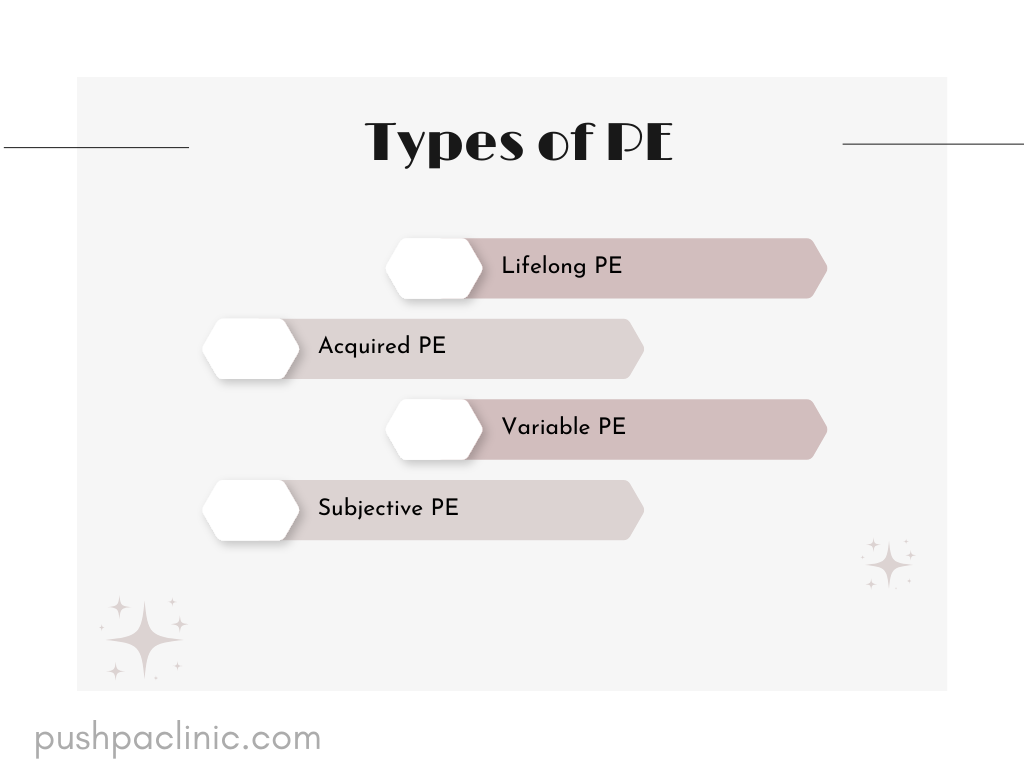What is premature ejaculation?
The most profound problem identified in men concerning sexual pleasure is the problem of Premature ejaculation (PE) which is often not addressed by many men due to lack of knowledge. The prevalence of this condition ranges between 4-39% across the population of men. The continuous onset of climax and ejaculation with limited stimulation, either before or shortly after that intromission takes place, is identified as premature ejaculation. This problem can exist lifelong or can be acquired. Urologic disorders and conditions like benign prostatic enlargement, prostatitis, and urethritis are examples of biological causes of premature ejaculation.

What causes PE?
Many basic factors such as parenting, conditioning, or a painful sexual encounter could result in primary PE. High blood pressure, diabetes, thyroid dysfunction, alcoholism, and recreational drug usage are all risk factors for recurrent PE. Psychological problems such as stress, tension, or despair related to intercourse can also lead to PE. Additionally, PE is linked to insomnia or lack of sleep, which causes the serotonin levels to drop. Treating this condition improves PE. The neurotransmitter serotonin (also called as 5HT) plays a critical role in controlling the ejaculatory response. Premature ejaculation may take place when the brain cannot produce enough serotonin. Improving serotonin levels in certain areas of the brain can delay the onset of arousal.

Symptoms
Being unable to postpone ejaculation for longer than a few minutes following penetration is the primary sign of untimely ejaculation. Nonetheless, it could take place in any kind of sexual setting up, including when performing masturbation.

Types of PE
There are broadly two kinds of PE; lifelong and acquired. Some research also classifies them into variable and subjective PE.
Lifelong PE: A short time before ejaculating during vaginal intercourse, usually less than a minute after beginning sexual activity, and consistently during future encounters, is the main characteristic of lifelong premature ejaculation. This type of PE is indicative of an operational issue, and it may be associated with irregularities in arousal, detumescence, and arousal timings.
Acquired PE: Acquired PE indicates decreased ejaculatory delay that an individual experiences at certain times in their lifetime. Individuals who have developed acquired PE have previously had functional ejaculations, and their disorder is typically caused by a known health, emotional, or behavioural factor. Problems such as endocrinological disorders (thyroid dysfunction, Diabetes Mellitus and related issues), urologic disorders (bladder related issues, difficulty in passing urine), and psychological dysfunction are risk factors for acquired PE. Other sexual comorbidities, most frequently erectile dysfunction, may also be prevalent among patients.
Variable PE: Premature ejaculation that happens erratically or haphazardly during an adult man's sexual activity is referred to as variable PE. This type of PE is considered a typical variation in ejaculatory time instead of a disease.
Subjective PE: Individuals who have subjective PE report or consider themselves as having ejaculated early even though their Low intravaginal ejaculation latency time, which is a measure of duration until ejaculation occurs during vaginal penetration, is normal.


Assessment of PE
To identify any aspects that could be considered conceivably removable, a thorough assessment of the individual's medical, sexual, psychiatric, interpersonal, and drug history must be conducted, coupled with the sexual history of his companion. It is important to understand whether the condition is acquired or lifelong while bearing in consideration that erectile dysfunction may make the symptoms worse. To differentiate between erectile dysfunction (ED) and premature ejaculation, one might just inquire about the loss of an erection before ejaculation.
Thorough assessment of the abdomen, lower limbs, neurological system, and genitalia are advised. Examining the patient helps to reassure him that he is anatomically normal, even though it has a low diagnostic yield. Premature ejaculation cannot be confirmed or ruled out by specialized research. Any further inquiries ought to investigate any suspicions regarding the indicated contributing variables.

Treatment
Non-medicinal treatments: PE is treated with a combination of cognitive behavioral interventions and psychological treatment. Behavioral therapy is more laborious, more expensive, and generally less successful than prescription drugs; it also loses effectiveness over time and necessitates substantial partnership obedience.
Techniques that enhance ejaculatory modulation comprise hypnotherapy, neuro-biofeedback, and relaxation/meditation. Patients with PE can benefit from a variety of forms of behavioural therapy, such as exercises for the pelvic floor, "stop-start" and "squeeze" methods, using several condoms, and masturbating before they have coitus
Medications: The majority of pharmacotherapeutic treatments tackle neurotransmitters involved with the ejaculation process, such as oxytocin and serotonin. The ejaculation latency time can be momentarily postponed by these therapies, which are only modestly successful, and PE returns whenever the procedure is dismissed.
